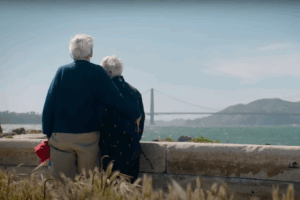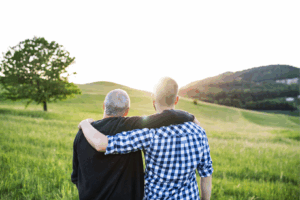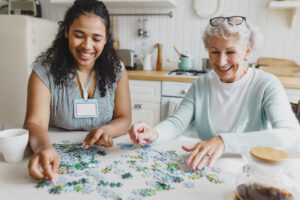It’s one of the most basic and simple things we can do: putting one foot in front of the other. Taking a step, then another one, and another, rotates the world under our feet, pulls the distance toward us, and brings a destination near. But a destination isn’t always needed. Just the act of walking itself—the motion, the head-clearing movements, the zen-like quality of our most basic motions—has enormous benefits, especially for older adults.
As we get older, the weighted burden of physical limitations can seem constraining, and seem like they are shrinking the world. But they don’t have to. Walking can be incredible exercise, nourishing for the body, mind, and spirit. And, for older adults in the Bay Area, the natural beauty, progressive attitudes toward exercise, abundant public outdoor spaces, and a vibrant community of active older adults, means walking can be an act of introspective solitude or communal fun, your opportunity to connect with the world, with friends, and with yourself. It’s just a matter of taking that first step.
The Benefits of Walking for Seniors
In 1955, Emma “Grandma” Gatewood became the first woman to hike the Appalachian Trail—at the age of 67. It was an epic walk, and inspired people across the nation. But the truth is, you don’t need to walk across the country to be healthy. Any amount of walking has enormous benefits for older adults.
- Improves your circulation. Many seniors suffer from poor circulation, which can lead to a lot of complications—organ damage, strokes, heart disease, and sometimes lowered brain function. But walking is one of the best cures for poor circulation. It’s been shown to reduce blood pressure in postmenopausal women by 11 points in just a few weeks, and also lowered their risk of stroke by 20%.
- Increases muscle strength. Walking can make a person stronger and improve balance, both of which reduce the danger of falls. A bad fall can break bones or increase mental impairment, leading to reduced independence, but regular walking can help to prevent this.
- Is just as good as running. There are a lot of people who think that walking isn’t real exercise, but a study from the Lawrence Berkeley National Laboratory showed that walking briskly is just as effective as running in reducing the risk of diabetes, heart disease, high blood pressure, and high cholesterol.
- Reduces pain. Walking can reduce the pain of arthritis, and other chronic geriatric pain. By strengthening abdominal and back muscles, it can also help to alleviate the lower back pain which plagues nearly 80% of the population.
- Increases lifespan. Studies have shown that walking as little as 75 minutes a week can add 1.8 years to a person’s life, and walking 450 minutes a week (or about 7.5 hours) can add between 4 and 5 years.
Beyond the physical benefits, and just as important, are the mental benefits. Walking, like many exercises, releases endorphins, reducing anxiety and helping people feel a deeper sense of well-being. A walk is a simple way to focus the mind, or let it wander. When taking a long, or even a short walk, you aren’t thinking about weights to lift or bikes to spin, and you aren’t really thinking about heart rates. It doesn’t seem like exercise. You’re just focusing on the motion of your body.
Experiment with walking with friends, or with a regular walking club. This has the added benefit of socialization, which is key in staving off depression. Not only that, but regular walks help to promote a routine and a schedule, both of which support the continued independence so vital to a healthy sense of self.
Hiking for Older Adults in the Bay Area
Residents of the Bay Area have always been very exercise friendly in a low-key way, as the proliferation of bike-riders proves. Maybe it’s the incredible beauty, or the thrust of jaw-dropping nature that crashes into the man-made scenery, but there’s something that just makes us want to get outside. That’s why it isn’t surprising there are dozens of walking clubs throughout San Francisco, including some especially for older adults.
Many older adult exercise clubs and groups offer hiking and walking classes, in cities all over the Bay, from San Jose to Mountain View, Santa Clara to Los Gatos. But you don’t always need a group. Here are five area hikes that are easy, accessible, and still very healthy for aging adults.
- Pillar Point (San Mateo): This 1.2-mile hike takes you from the outskirts of Princeton Harbor down to the beach, and offers beautiful views of the coast, the bluffs, and the roaring shores. It’s an easy and pleasant walk with almost no elevation.
- Crissy Field (San Francisco): On this 3.3-mile, mostly level walk,you’ll pass by some of the most famous and scenic areas in the country, including the Golden Gate Bridge and Fort Point.
- Martin Luther King Jr Regional Shoreline (Oakland): A beautiful, and unexpected, 1.7-mile walk through the Oakland wetlands, a lesser-known natural area right off San Leandro Bay. You may see a variety of beautiful birds, including hawks, swallows, and egrets.
- Deer Island Open Space Reserve (Marin): Around the base of a hill that alternates from woody and secluded to wide open, this 1.8-mile loop has an elevation change of an easy, but hearty, 140 feet. This one is also great for bird watchers, as hawks have been seen all around it.
- Muddy Hollow (Marin): A much longer walk through the Point Reyes coastal scrub, this 7-mile walk might offer the opportunity to see wild elk, amazing flowers, or even hear the bark of sea lions. With an elevation shift of 700 feet, this is for people who are ready to push themselves.
This list barely scratches the surface. Here’s a comprehensive list of Bay Area trails so you can find a walk near you, or to a spot you’ve never been. Walking is, after all, an exploration, every time.
The truth is, you can walk through the wilds of the Bay, or you can walk around your neighborhood. It doesn’t really matter. What does matter is getting out there, by yourself or with friends new and old, and getting exercise. It supports the body, strengthens the mind, and promotes independence.
Walking upright is what first made us human, when we left the trees and began the long course toward making our great cities. And continuing on that journey, following those footsteps, is a great way for older adults to reaffirm their own humanity, every day.
At Institute on Aging, we promote healthy and independent lifestyles for older adults, balancing physical, mental, and emotional well-being for our aging loved ones and their families. To learn more about our programs, please connect with us today.






